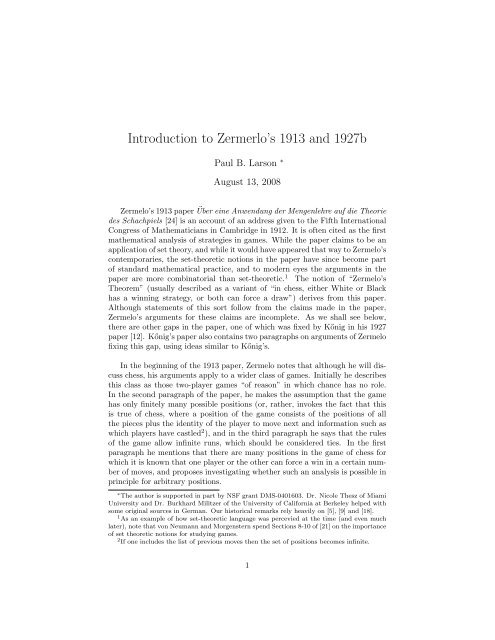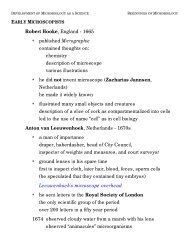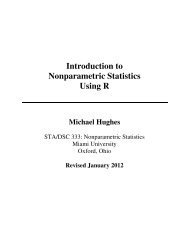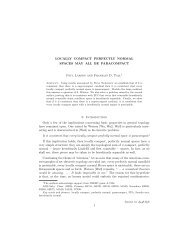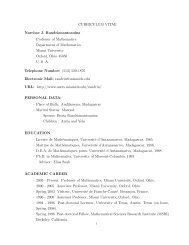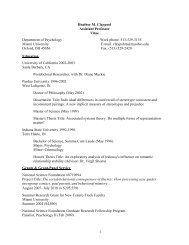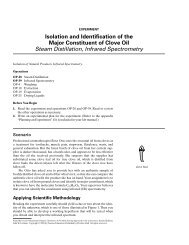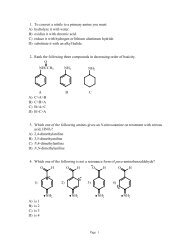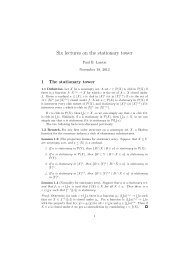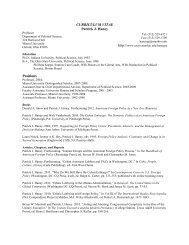Introduction to Zermerlo's 1913 and 1927b - Users.muohio.edu
Introduction to Zermerlo's 1913 and 1927b - Users.muohio.edu
Introduction to Zermerlo's 1913 and 1927b - Users.muohio.edu
Create successful ePaper yourself
Turn your PDF publications into a flip-book with our unique Google optimized e-Paper software.
<strong>Introduction</strong> <strong>to</strong> Zermerlo’s <strong>1913</strong> <strong>and</strong> <strong>1927b</strong><br />
Paul B. Larson ∗<br />
August 13, 2008<br />
Zermelo’s <strong>1913</strong> paper Über eine Anwendung der Mengenlehre auf die Theorie<br />
des Schachpiels [24] is an account of an address given <strong>to</strong> the Fifth International<br />
Congress of Mathematicians in Cambridge in 1912. It is often cited as the first<br />
mathematical analysis of strategies in games. While the paper claims <strong>to</strong> be an<br />
application of set theory, <strong>and</strong> while it would have appeared that way <strong>to</strong> Zermelo’s<br />
contemporaries, the set-theoretic notions in the paper have since become part<br />
of st<strong>and</strong>ard mathematical practice, <strong>and</strong> <strong>to</strong> modern eyes the arguments in the<br />
paper are more combina<strong>to</strong>rial than set-theoretic. 1 The notion of “Zermelo’s<br />
Theorem” (usually described as a variant of “in chess, either White or Black<br />
has a winning strategy, or both can force a draw”) derives from this paper.<br />
Although statements of this sort follow from the claims made in the paper,<br />
Zermelo’s arguments for these claims are incomplete. As we shall see below,<br />
there are other gaps in the paper, one of which was fixed by Kőnig in his 1927<br />
paper [12]. Kőnig’s paper also contains two paragraphs on arguments of Zermelo<br />
fixing this gap, using ideas similar <strong>to</strong> Kőnig’s.<br />
In the beginning of the <strong>1913</strong> paper, Zermelo notes that although he will discuss<br />
chess, his arguments apply <strong>to</strong> a wider class of games. Initially he describes<br />
this class as those two-player games “of reason” in which chance has no role.<br />
In the second paragraph of the paper, he makes the assumption that the game<br />
has only finitely many possible positions (or, rather, invokes the fact that this<br />
is true of chess, where a position of the game consists of the positions of all<br />
the pieces plus the identity of the player <strong>to</strong> move next <strong>and</strong> information such as<br />
which players have castled 2 ), <strong>and</strong> in the third paragraph he says that the rules<br />
of the game allow infinite runs, which should be considered ties. In the first<br />
paragraph he mentions that there are many positions in the game of chess for<br />
which it is known that one player or the other can force a win in a certain number<br />
of moves, <strong>and</strong> proposes investigating whether such an analysis is possible in<br />
principle for arbitrary positions.<br />
∗ The author is supported in part by NSF grant DMS-0401603. Dr. Nicole Thesz of Miami<br />
University <strong>and</strong> Dr. Burkhard Militzer of the University of California at Berkeley helped with<br />
some original sources in German. Our his<strong>to</strong>rical remarks rely heavily on [5], [9] <strong>and</strong> [18].<br />
1 As an example of how set-theoretic language was percevied at the time (<strong>and</strong> even much<br />
later), note that von Neumann <strong>and</strong> Morgenstern spend Sections 8-10 of [21] on the importance<br />
of set theoretic notions for studying games.<br />
2 If one includes the list of previous moves then the set of positions becomes infinite.<br />
1
Zermelo’s analysis begins by letting P denote the set of all possible positions<br />
of the game, <strong>and</strong> letting P a denote the set of countable sequences of positions,<br />
finite or infinite. Fixing a position q, he lets Q be the set of all sequences in P a<br />
starting with q, such that, for each successive pair of positions in the sequence<br />
the latter member is obtained by a legal move from the former, <strong>and</strong> such that<br />
the sequence either continues infinitely or ends with a stalemate or a win for one<br />
player or the other. Zermelo notes that given a position q <strong>and</strong> a natural number<br />
r (Zermelo is not explicit about whether the case r = 0 is <strong>to</strong> be included), White<br />
can force a win from q in at most r moves if <strong>and</strong> only if there is a nonempty set<br />
U r (q) of members of Q such that each q in U r (q) is a continuation of q in which<br />
White wins in at most r moves (starting from q), <strong>and</strong> such that for each q ∈ Q<br />
<strong>and</strong> each position in q where it is Black’s turn <strong>to</strong> move, <strong>and</strong> for each possible<br />
move for Black at that point, there is a q ′ ∈ Q which agrees with q up <strong>to</strong> this<br />
point, <strong>and</strong> has the position resulting from Black making this move as its next<br />
member. In more modern terminology (appearing no later than [13]), Zermelo<br />
has introduced here a game-tree with root q of height at most r + 1, in which<br />
all terminal nodes are wins for White, <strong>and</strong> in which all nodes for which it is<br />
Black’s turn <strong>to</strong> move have successors corresponding <strong>to</strong> every move available <strong>to</strong><br />
Black at that position. The existence of such a tree is indeed equivalent <strong>to</strong> the<br />
existence of a quasi-strategy 3 for White guaranteeing a win in r moves or fewer:<br />
White simply plays <strong>to</strong> maintain the condition that the continuation of the game<br />
starting from q is an initial segment of a member of U r (q).<br />
Still fixing q <strong>and</strong> r, Zermelo notes that the union of all such sets U r (q) would<br />
also satisfy the conditions on U r (q). He calls this union Ūr(q), <strong>and</strong> notes that<br />
as r increases the sets Ūr(q) also increase under ⊆ (though of course they may<br />
eventually all be the same, <strong>and</strong> may all be the empty set). For each q such that<br />
Ū r (q) is nonempty for some natural number r, Zermelo lets ρ q be the least such<br />
r, <strong>and</strong> he lets U ∗ (q) denote Ūρ q<br />
(q). He also lets τ denote the maximum of the<br />
set of defined values ρ q .<br />
Zermelo lets t be the integer such that t + 1 is the size of P , <strong>and</strong> presents<br />
an argument <strong>to</strong> the effect that τ ≤ t. The idea behind this argument is that if<br />
some position is repeated during a play by a winning quasi-strategy for White,<br />
then one could adjust the quasi-strategy <strong>to</strong> play from the first occurrence of<br />
this position in the way that one played from the second, thus winning in fewer<br />
moves. This argument was later shown by Kőnig [12] <strong>to</strong> be incomplete, as it<br />
does not account for all possible sequences of moves for Black; that is, playing<br />
with the same strategy does not guarantee the same resulting sequence of moves.<br />
For each q, Zermelo lets U(q) denote Ūτ (q), <strong>and</strong> claims that U(q) being<br />
nonempty is equivalent <strong>to</strong> the assertion that q is a winning position for White.<br />
In fact, U(q) being nonempty is equivalent <strong>to</strong> the existence of some natural<br />
number r such that White has a quasi-strategy guaranteeing a win in r moves<br />
3 A strategy for White specifies a move for White in each position obtainable by the strategy;<br />
a quasi-strategy merely specifies an acceptable set of moves (see [10]). The distinction<br />
is important when the Axiom of Choice fails, but is less important here, since P is finite.<br />
Nonetheless, we will use the term “quasi-strategy” for the sets of sequences described by<br />
Zermelo in this paper.<br />
2
or fewer. Zermelo does not address in this paper what it means for a player <strong>to</strong><br />
have a quasi-strategy guaranteeing a win without specifying an upper bound on<br />
the number of moves needed <strong>to</strong> win. Kőnig’s subsequent work [12] would show<br />
that in games in which each player has only finitely many moves available in<br />
each position, having a winning quasi-strategy in this more general sense implies<br />
having one with a fixed upper bound for the number of moves needed.<br />
Zermelo then defines sets V s (q), analogous <strong>to</strong> U s (q) except that the corresponding<br />
quasi-strategies merely guarantee that White does not lose in fewer<br />
than s moves, though they allow that White loses on the s-th move. So each<br />
V s (q) is a set of members of Q such that each q in V s (q) is a continuation of q<br />
in which White does not lose in fewer than s moves starting from q, <strong>and</strong> such<br />
that for each q ∈ V s (q) <strong>and</strong> each position in q where it is Black’s turn <strong>to</strong> move,<br />
<strong>and</strong> for each possible move for Black at that point, there is a q ′ ∈ V s (q) which<br />
agrees with q up <strong>to</strong> this point, <strong>and</strong> has the position resulting from Black making<br />
this move as its next member. Again, the union ¯V s (q) of all such V s (q) satisfies<br />
these conditions. Now, however, the sets ¯V s (q) are shrinking as s increases.<br />
Zermelo now remarks that, given q, if ¯V s (q) is empty for any positive integer<br />
s, then, letting σ be the maximal s for which ¯V (s) is nonempty, σ ≤ τ (he also<br />
lets V ∗ (q) denote ¯V σ (q) in this case). The argument for this is not given (Zermelo<br />
also reiterates here that τ ≤ t, which, as we noted above, is not satisfac<strong>to</strong>rily<br />
demonstrated in this paper, but that issue does not affect this one.) The first<br />
missing claim is that if ¯V s (q) is empty, then Black has a quasi-strategy which<br />
guarantees a win in s − 1 moves or fewer, starting from q. Modulo precise<br />
notions of game <strong>and</strong> strategy, this fact is sometimes called determinacy for fixed<br />
finite length games of perfect information; indeed, this assertion is often called<br />
Zermelo’s Theorem, referring <strong>to</strong> the arguments in this paper (a generalization<br />
is called “the theorem of Zermelo-von Neumann” in [13]). Granting this point,<br />
one needs <strong>to</strong> see that if Black has a quasi-strategy guaranteeing a win in s − 1<br />
moves or fewer, then he or she has a quasi-strategy guaranteeing a win in τ<br />
moves or fewer. Given the definition of τ this is clear for suitably symmetric<br />
games, 4 but it need not hold in general. Finally, it is clear that if Black has a<br />
quasi-strategy that guarantees a win in τ moves or fewer starting from q, then<br />
¯V τ+1 (q) is empty.<br />
Zermelo lets V (q) denote ¯V τ+1 (q), <strong>and</strong> claims that V (q) being nonempty is<br />
equivalent <strong>to</strong> White being able <strong>to</strong> force a draw from the position q. This claim<br />
is missing the same steps as the corresponding claim for U(q) above. Given<br />
that the game is suitably symmetric, the statement that V (q) is nonempty<br />
is equivalent <strong>to</strong> the statement that White can delay a loss by any specified<br />
amount he or she chooses, which again by the subsequent work of Kőnig <strong>and</strong><br />
the finiteness of chess means being able <strong>to</strong> delay a loss indefinitely.<br />
The second-<strong>to</strong>-last paragraph of the paper provides a partial summary, <strong>and</strong><br />
asserts in a roundabout manner that in chess, either one player or the other<br />
4 That is, games where for every position where it is White’s term <strong>to</strong> move there is a position<br />
where is it Black’s turn such that the game trees below the two conditions are isomorphic.<br />
Strictly speaking this is not true of chess, since it can only be White’s turn when the pieces<br />
are in their initial position.<br />
3
has a winning strategy, or both players can force a draw. Zermelo notes that in<br />
each position q, U(q) ⊆ V (q), <strong>and</strong> if U(q) is nonempty, then White can force a<br />
win from q. If U(q) is empty but V (q) is not, then White can force a draw (as<br />
we mentioned in the previous paragraph, this is true but not supported by the<br />
arguments in the paper). If both sets are empty, then White can delay a loss<br />
until the σ-th move, for the value of σ corresponding <strong>to</strong> q. Furthermore, the<br />
two sets U ∗ (q) (in the case where White can force a win) <strong>and</strong> V ∗ (q) (otherwise)<br />
make up the set of “correct” moves for White from the position q. Zermelo<br />
notes than an analogous situation holds for Black, so that there exists a subset<br />
W (q) of Q consisting of all continuations of the game (starting from q) in which<br />
both players can be said <strong>to</strong> have played correctly.<br />
The final paragraph of the paper notes that the paper gives no means of<br />
determining in general which player has a winning strategy from which positions<br />
in chess, <strong>and</strong> that, given such a method, chess would in some sense cease <strong>to</strong> be<br />
a game.<br />
As mentioned above, Kőnig’s 1927 paper [12] points out that Zermelo’s argument<br />
for the statement τ ≤ t is incomplete. Kőnig’s proof of this statement uses<br />
the following statement, which had appeared in his 1926 paper [11] (as translated<br />
in [18] from [12]; see [6] for much more on the his<strong>to</strong>ry of this statement): if<br />
E i (i ∈ N) are nonempty finite sets <strong>and</strong> R is a binary relation such that for each<br />
i ∈ N <strong>and</strong> each x ∈ E i+1 there is a y ∈ E i such that (y, x) ∈ R, then there exists<br />
a sequence 〈x i : i ∈ N〉 such that each x i ∈ E i <strong>and</strong> (x i , x i+1 ) ∈ R for all i ∈ N<br />
(where N denotes the set of natural numbers). This principle is now known as<br />
Kőnig’s lemma, often rephrased as “every infinite finitely-branching tree has an<br />
infinite branch.” Kőnig uses this principle <strong>to</strong> prove that if G is a game in which<br />
each player has only finitely many available moves at each point, <strong>and</strong> one player<br />
has a winning strategy in this game, then this player has a strategy guaranteeing<br />
a win within a fixed number of moves. Kőnig credits this application of his<br />
lemma <strong>to</strong> a suggestion of von Neumann.<br />
Before publishing his paper, Kőnig wrote <strong>to</strong> Zermelo, pointing out the gap<br />
in Zermelo’s argument for τ ≤ t, <strong>and</strong> providing a correct proof. Zermelo then<br />
replied with a correct proof of his own. Zermelo’s <strong>1927b</strong> consists of two paragraphs<br />
in the final section of Kőnig’s 1927 paper pertaining <strong>to</strong> Zermelo’s corrected<br />
proof.<br />
The first paragraph was apparently written by Kőnig, summarizing Zermelo’s<br />
arguement. It contains a proof that if White can force a win from a<br />
given position within some fixed number of moves, then White has a winning<br />
strategy that guarantees a win in fewer than t moves, where t is the number of<br />
positions in the game where it is White’s turn <strong>to</strong> move (note that the definition<br />
of t has changed; this t is smaller than the t from [24], as we are counting only<br />
the number of moves that White makes). To show this, Zermelo lets m r , for<br />
each positive integer r, be the number of such positions from which White can<br />
force a win in at most r moves, but cannot force a win in fewer moves (though<br />
Zermelo does not give a name for the set of such positions, let us call it M r ).<br />
Since the corresponding sets of positions are disjoint, <strong>and</strong> since there are only<br />
4
finitely many possible positions in the game, m r is nonzero for only finitely<br />
many values of r. Furthermore, if p is a position from which White can win<br />
in at most r moves (for some r > 1) by first playing w 1 , then there must be a<br />
response by Black such that the resulting position is in M r−1 , since from every<br />
such position White can win in at most r − 1 many moves, but if he could win<br />
in fewer moves from every such position, then White could win in fewer than r<br />
moves from the position p. Zermelo concludes that the set of values r such that<br />
m r is positive is an initial sequence of the set of positive integers, so if λ is the<br />
largest integer r such that m r is positive, then m r ≥ 1 for all positive integers<br />
r ≤ λ. Then m = ∑ λ<br />
r=1 m r is smaller than the number of positions in which<br />
it is White’s turn <strong>to</strong> play (since, for instance, Black can force a win from some<br />
such positions), so λ must be smaller than this version of t. This establishes<br />
that if p is a position from which White can force a win in at most r moves<br />
(for White), for some positive integer r, then r is less than the <strong>to</strong>tal number of<br />
positions in which it is White’s turn <strong>to</strong> move.<br />
In the second paragraph, Kőnig quotes Zermelo directly. Zermelo gives a<br />
proof that if White has a strategy guaranteeing a win, then he has one guaranteeing<br />
a win in a fixed number of moves. This is shown by Kőnig using his<br />
lemma, <strong>and</strong> Zermelo’s argument uses the same idea (<strong>and</strong> implicitly includes a<br />
proof of the lemma). In brief, suppose that p is a position from which White<br />
cannot force a win in a fixed number of moves. Then no matter how White<br />
plays, there must be a move for Black such that White cannot force a win in a<br />
fixed number of moves from the resulting position (if each resulting position p ′<br />
were in some M r ′, then p would be in M r+1 for r the supremum of these values<br />
r ′ – this uses the fact that each player has just finitely many possible available<br />
moves at each point). This observation gives a strategy for Black <strong>to</strong> postpone<br />
a loss forever, by always moving <strong>to</strong> ensure that the resulting position is not in<br />
any set M r , contradicting the assumption that White has a winning strategy.<br />
Kalmár [8] extended Kőnig’s analysis <strong>to</strong> games where there may be infinitely<br />
many possible moves at some points. In this paper he proved what is now known<br />
as Zermelo’s Theorem for these games, the statement that in each position of<br />
such a game, either one player or the other has a strategy guaranteeing a win,<br />
or both players can force a draw. His proof uses a ranking of nodes in the<br />
game tree by transfinite ordinals, which was <strong>to</strong> become an important method in<br />
descriptive set theory (see [10]). Using this method, he was able <strong>to</strong> show that<br />
if a player has a winning strategy in such a game, then he has one in which no<br />
position is repeated, thus realizing Zermelo’s idea from his <strong>1913</strong> paper.<br />
Aside from the work of Kőnig <strong>and</strong> Kalmár, Zermelo’s <strong>1913</strong> paper would<br />
seem <strong>to</strong> have been forgotten for several decades after it was written. In the<br />
interval between Zermelo’s paper <strong>and</strong> Kőnig’s, Emile Borel published several<br />
notes on game theory (for example, [1, 2, 3]), none of which mentions Zermelo.<br />
Von Neumann’s work in game theory began during this period, <strong>and</strong> though he<br />
5
was informed of Zermelo’s work by Kőnig, 5 he does not cite it in his 1928 paper<br />
[20]. Zermelo’s <strong>1913</strong> paper is not mentioned in von Neumann <strong>and</strong> Morgenstern’s<br />
book [21], which is often cited as the birthplace of game theory. Many authors<br />
credit the birth of game theory <strong>to</strong> some combination of Borel, von Neumann<br />
<strong>and</strong> Morgenstern (for instance, [15, 23, 19, 22, 7, 17, 16], <strong>and</strong> among these only<br />
[15, 23, 7] credit Borel). Aside from the work of Kőnig <strong>and</strong> Kalmár, the earliest<br />
citation of Zermelo’s <strong>1913</strong> paper that we have been able <strong>to</strong> find is Kuhn’s paper<br />
[13]. Kuhn credits Zermelo with proving that “a zero-sum two-person game<br />
with perfect information always has a saddle-point in pure strategies.” As we<br />
have seen, the argument that Zermelo gives for this fact in his <strong>1913</strong> paper is<br />
incomplete. Although Zermelo’s focus was on other issues, it seems fair <strong>to</strong> say<br />
that this fact is the most significant contribution of his paper.<br />
References<br />
[1] E. Borel, La théorie du jeu et les équations intégrales à noyau symétrique,<br />
Comptes Rendus Academie des Sciences, Vol. 173, 1921, pp. 1304-1308;<br />
English translation in [4]<br />
[2] E. Borel, Sur les jeux où interviennent l’hasard et l’habileté des joueurs,<br />
Théorie des Probabilitiés, Paris : Librairie Scientifique, J. Hermann,<br />
1924, pp. 204-224; English translation in [4]<br />
[3] E. Borel, Sur les systèmes de formes linéaires à determinant symétrique<br />
gauche et la théorie générale de jeu, Comptes Rendus Academie des Sciences,<br />
Vol. 184, 1927, pp. 52-54; English translation in [4]<br />
[4] M.A. Dim<strong>and</strong>, R.W. Dim<strong>and</strong>, eds., The Foundations of Game Theory,<br />
Aldershot: Edward Elger, 1997<br />
[5] H.-D. Ebbinghaus, Ernst Zermelo. An approach <strong>to</strong> his life <strong>and</strong> work,<br />
Springer, 2007<br />
[6] M. Franchella, On the origins of Dénes Kőnig’s infinity lemma, Arch. Hist.<br />
Exact Sci. 51 (1997), 3-27.<br />
[7] A.J. Jones, Game Theory : Mathematical Models of Conflict, Horwood<br />
Publishing Limited, 2000<br />
[8] L. Kalmár, Zur Theorie der abstrakten Spiele, Acta. Sci. Math. Szeged 4<br />
(1928/1929), 65-85; English translation in [4]<br />
[9] A. Kanamori, Zermelo <strong>and</strong> set theory, Bulletin of Symbolic Logic 10 (2004)<br />
4, 487-553<br />
[10] A.S. Kechris, Classical Descriptive Set Theory, Springer-Verlag, 1995<br />
5 According <strong>to</strong> Kőnig in a 1927 letter <strong>to</strong> Zermelo, see [5].<br />
6
[11] D. Kőnig, Sur les correspondances multivoques des ensembles, Fund. Math.<br />
8 (1926), 114-134<br />
[12] D. Kőnig, Über eine Schlussweisse aus dem Endlichen ins Unendliche, Acta<br />
Sci. Math. Szeged 3 (1927), 121-130<br />
[13] H.W. Kuhn, Extensive games the problem of information, in [14], 193-216<br />
[14] H.W. Kuhn, A.W. Tucker, eds., Contributions <strong>to</strong> the Theory of<br />
Games, vol. 2, Annals of Mathematical Studies 28, Prince<strong>to</strong>n University<br />
Press, Prince<strong>to</strong>n, N. J., 1953<br />
[15] H.D. Luce, H. Raiffa, Games <strong>and</strong> Decisions : A study of the Behavioral<br />
Models Project, Bureau of Applied Social Research, Columbia<br />
University, 1957<br />
[16] E. Mendelson, Introducing Game Theory <strong>and</strong> Its Applications,<br />
Chapman & Hall/CRC, 2004<br />
[17] K. Ritzberger, Foundations of Non-Cooperative Game Theory, Oxford<br />
University Press, 2002<br />
[18] U. Schwalbe, P. Walker Zermelo <strong>and</strong> the Early His<strong>to</strong>ry of Game Theory,<br />
Games <strong>and</strong> Economic Behavior 34 (2001), 123-137<br />
[19] Straffin, Game Theory <strong>and</strong> Strategy, Mathematical Association of<br />
America, 1993<br />
[20] J. von Neumann, Zur Theorie der Gesellschaftsspiele, Math. Annal. 100,<br />
295-320; English translation in [4]<br />
[21] J. von Neumann, O. Morgenstern, Theory of Games <strong>and</strong> Economic<br />
Behavior, Prince<strong>to</strong>n, Prince<strong>to</strong>n University Press 1943<br />
[22] N.N. Vorob’ev, Foundations of Game Theory : Noncooperative<br />
Games, Birkhauser, 1994<br />
[23] F.C. Zagare, Game Theory : Concepts <strong>and</strong> Applications, Quantitative<br />
Applications in the Social Sciences, Sage Publications, 1984<br />
[24] E. Zermelo, Über eine Anwendung der Mengenlehre auf die Theorie des<br />
Schachpiels, Proc. Fifth Congress Mathematicians, (Cambridge 1912),<br />
Cambridge Univ. Press <strong>1913</strong>, 501-504<br />
Department of Mathematics <strong>and</strong> Statistics<br />
Miami University<br />
Oxford, Ohio 45056<br />
USA<br />
larsonpb@<strong>muohio</strong>.<strong>edu</strong><br />
7


